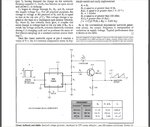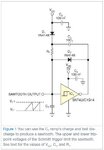d123
Advanced Member level 5
Hi,
My SEPIC doesn't work, sometimes the voltage is too high, sometimes the voltage is too low, why?
(see attached image)
Sorry, just a little joke there. I am having a lot of problems getting the SEPIC to regulate the output voltage to 5V. I followed the advice of using a lower frequency and chose 100kHz, then dropped it to 90kHz to fit the 680uH inductors better.
The output is always between 2.2V or approx.4V whatever the load. The intended load should be 100mA, this very bad SEPIC of mine cannot even handle 4mA, it would seem.
I've been through anything I think that could be a problem more than once, and may hit the breadboard with a hammer, in case it helps:
It doesn't seem to be the input/coupling/output capacitor values.
I can't see the inductor current waveform, unfotunately.
Lowering the frequency to 50kHz or even 30kHz makes little difference/improvement.
The Vref is good at 2.48 - 2.49V, the divider quite accurately divides 2.440V into 1.221V.
FOsc is stable at 90.1kHz at measured points.
The error amplifier is on when Vout is below (Vref) 5V and off when above (tried it with no load at 30kHz and got approx 7V out).
Questions: Should the error amplifier and Vref be picking up the 90kHz, or could that be the DMM frequency counter misreading, as the oscilloscope shows no such thing?
Why could I be getting very random and varying frequency values on the breadboard? Is that because it's a breadboard?
If the SEPIC is never at 5V, and much less with a 56ohm load, is it probable that I have got the calculations wrong?
Thank you.
Attached is the snva168e where I got the calculations from for CCM, the measured results from last night, the schematic, and a document with a photo of the breadboard, the oscilloscope screen (empathise a little...) and how I'm measuring things (directly in the adjacent breadboard hole or directly on the pins of interest).
My SEPIC doesn't work, sometimes the voltage is too high, sometimes the voltage is too low, why?
(see attached image)
Sorry, just a little joke there. I am having a lot of problems getting the SEPIC to regulate the output voltage to 5V. I followed the advice of using a lower frequency and chose 100kHz, then dropped it to 90kHz to fit the 680uH inductors better.
The output is always between 2.2V or approx.4V whatever the load. The intended load should be 100mA, this very bad SEPIC of mine cannot even handle 4mA, it would seem.
I've been through anything I think that could be a problem more than once, and may hit the breadboard with a hammer, in case it helps:
It doesn't seem to be the input/coupling/output capacitor values.
I can't see the inductor current waveform, unfotunately.
Lowering the frequency to 50kHz or even 30kHz makes little difference/improvement.
The Vref is good at 2.48 - 2.49V, the divider quite accurately divides 2.440V into 1.221V.
FOsc is stable at 90.1kHz at measured points.
The error amplifier is on when Vout is below (Vref) 5V and off when above (tried it with no load at 30kHz and got approx 7V out).
Questions: Should the error amplifier and Vref be picking up the 90kHz, or could that be the DMM frequency counter misreading, as the oscilloscope shows no such thing?
Why could I be getting very random and varying frequency values on the breadboard? Is that because it's a breadboard?
If the SEPIC is never at 5V, and much less with a 56ohm load, is it probable that I have got the calculations wrong?
Thank you.
Attached is the snva168e where I got the calculations from for CCM, the measured results from last night, the schematic, and a document with a photo of the breadboard, the oscilloscope screen (empathise a little...) and how I'm measuring things (directly in the adjacent breadboard hole or directly on the pins of interest).




